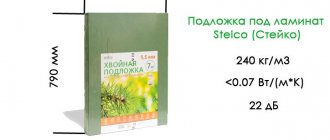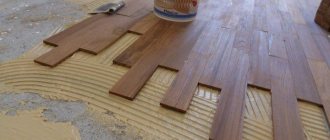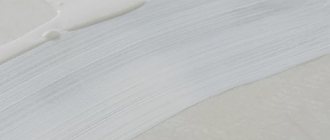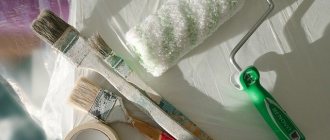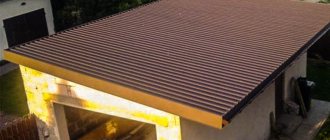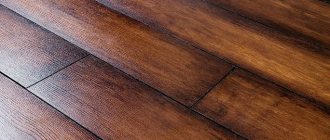Parquet boards have a number of advantages, for which they are highly valued by lovers of natural floor coverings. Parquet flooring is durable and looks presentable, is pleasant to the touch, does not accumulate static electricity, and can be restored several times. Laying the coating is possible using the adhesive method, using hardware, and floating, using a substrate, the purpose and types of which will be discussed in this article.
Underlay for parquet boards
A few words about parquet boards
In order to install the coating without errors, it is worth knowing what qualities and characteristics a parquet board, otherwise known as solid parquet, has.
Parquet boards in the interior, photo
So, parquet board is a finishing material, similar in appearance to block parquet or solid board. However, unlike solid boards and parquet, parquet boards have interlocking joints and have a multi-layer structure.
Depending on the manufacturer, the structure may vary slightly, but in most cases it is the following cake:
- solid veneer of coniferous or hardwood in the bottom layer;
- cross bars made of coniferous wood in the middle layer;
- lamellas made of valuable species in the top layer. There may be wenge, merbau, teak, ash, etc. wood. It is important to take this into account when choosing a solid board as a floor covering over a heated floor, since not all varieties can withstand such operating conditions.
The parquet board has a rather complex structure, consisting of several layers glued together.
The lamellas of the top layer can be arranged in one, two or three stripes. You can also find a massive board with a herringbone, wicker, checker, or Dutch pattern.
Dutch drawing
French Christmas tree 3-layer
"Chess field"
The dimensions of the parquet board can be within the following limits:
- 110-250 cm length;
- 12-20 cm width;
- 1-2.2 cm thickness.
For comparison, the thickness of parquet blocks is 1.5-2.2 cm, and the length is no more than 50 cm.
Parquet and parquet boards
Criterias of choice
When choosing a substrate for a parquet board, you should focus on several basic criteria:
Thickness
When it is necessary to decide on the thickness of the layer of underlay material, many people think that the maximum thickness is preferable - the floor becomes warmer and sound insulation increases. If we consider the issue based on the laws of physics, everything is correct - a warm and soundproof floor can be made by laying a thick layer, but here we must also take into account the performance of the floor covering under load.
The thicker the lining under the finishing coating, the higher the amplitude of vibration under load.
According to GOST, this figure should not exceed 2-3 mm, which is ensured by a substrate of the same thickness, but if you lay a double layer of 4-6 mm, the amplitude will double, which will cause the locking joints to break.
Considering the negative impact of thickness on the safety of connecting locks, the ideal option for parquet is material with a thickness of no more than 3 mm.
Price
Low-cost underlays are usually used when laying laminate flooring. This is due to the period of operation of the coating, which does not exceed 15 years, then both the laminate and the substrate have to be completely changed.
Parquet is designed to last for 50 years or more, so you cannot choose cheap and short-lived options.
Durable materials usually include cork, coniferous or bitumen-cork products.
Durability
Durability is similar to the cost criterion. For parquet, you should choose strong and durable products made from cork or pine needles.
Insulating properties
The ability of the substrate to insulate the coating from sound and cold air depends on the base material. It is better to lay a cork or bitumen-cork substrate on concrete or self-leveling floors. It is better to lay coniferous material on wood or plywood.
Conditions for laying solid parquet
Solid parquet can be laid on a flat, hard and dry base, for example, plywood, screed, ceramic tiles and even old parquet. Each case has its own nuances.
Plywood as a base
Plywood must be laid and fixed using a certain technology.
- Sheets should be divided into rectangles or squares with a side of no more than 50-80 cm.
- The joints of the plywood should be located at an angle of 45 degrees relative to the joints of the subsequently laid parquet boards.
Plywood base for parquet boards - It is necessary to leave a compensation gap of 5 mm between the sheets. If you do not leave a gap, when the humidity changes, the linear dimensions of the sheets may change, the edges may rub against each other, and a noticeably loud creaking noise may occur when walking on the floor.
- Each sheet with a side of about 70 cm must be secured with nine self-tapping screws. The hats are embedded flush into the material.
Carefully recess the screw heads - The surface of the sheets, if necessary, must be sanded and dust-free.
- A backing should be laid on top of the plywood, laid with a difference of no more than 2 mm for every 2 square meters.
Sheet backing. Example. The seams are taped together
On a note!
Large air pockets formed between the finished floor covering and the unleveled sub-base lead to drying out of the solid parquet and the appearance of cracks and creaks.
Base - concrete screed
The screed must be completely dry, level and clean. If possible, it is worth checking the compressive strength of the screed; the optimal indicator is at least 10 MPa.
To check the evenness of the screed, you can use a long rule or level. The permissible level of height difference is within 2 mm per 2 square meters of floor area.
Checking the evenness of the screed
An electronic moisture meter is used to check humidity.
Device for determining the moisture content of a concrete floor
The optimal indicator is no more than 2%. If the humidity is higher than this indicator, you can postpone the installation of the parquet board for a while or cover the screed with an insulating primer that prevents the capillary upward movement of moisture.
Epoxy primer for screed
The applied primer must also dry well, this may take 3-5 days.
Other rough foundations
Installation conditions are similar to those listed above. This applies to the strength of the base, its evenness, and humidity levels. If the base is ceramic tiles, it is important that they do not peel off, are strong enough and without cracks.
Piece coatings should also be inspected for swelling, traces of mold and damage; if any are found, repairs must be made. Cracks in wooden bases can be repaired with putty.
Sealing cracks in wood floors
Before installing the parquet board, all rough substrates must be vacuumed or washed and wiped dry.
Floors
0 votes
+
Vote for!
—
Vote against!
Parquet boards can be laid on a concrete screed, wooden floor or plywood base. Regardless of the type of rough coating, most craftsmen claim that waterproofing and underlayment are prerequisites for proper installation. Why is it so important to make a layer between the base and the coating itself? The article will discuss which underlay for parquet boards is better.
What are the benefits of using an underlay for parquet boards?
We should start with the fact that any material laid under a parquet board has a couple of important missions: to extend the life of the floor covering and make its use as comfortable as possible. But these goals are achieved due to the following qualities of the substrate:
- Correction of minor surface imperfections . Many may doubt the “need” of this quality, because before laying the board, the floor surface is leveled in one way or another. This is true, but even a very experienced builder finds it difficult to achieve perfect evenness, for example, of a cement screed. So it’s definitely not worth saving on the substrate for this one item.
- Additional thermal insulation . In addition to the fact that the warmth of the base under our feet is a very common criterion by which comfort and coziness in the house are assessed, the substrate normalizes the microclimate between the base and the final finishing material.
- Noise insulation . In addition to low thermal conductivity, the substrates dampen the noise of the apartment owners' footsteps and work in the opposite direction. That is, they do not allow noise from neighbors below to pass through. Convenience for the inhabitants of two apartments is ensured by one material. And in addition to steps, the substrate will dampen vibrations and the sounds of household appliances.
- Waterproofing. Its necessity has already been mentioned above. In order for a parquet board to serve for a long time and not deform, it needs protection from moisture regardless of the microclimate in the house or apartment. The substrates, to one degree or another, serve as a barrier between water and the parquet board.
All of the listed characteristics are, to a greater or lesser extent, inherent in the substrates that will be discussed below. In addition to such characteristics, it is important for the consumer to have such qualities as:
- durability of the material;
- its environmental friendliness and safety;
- strength (so that the weight of the furniture and large crowds of people do not affect the substrate);
- and, of course, the price.
The choice of materials is large, and they all have different properties. It makes sense to compare the pros and cons of each to find the ideal.
Tuplex backing
It is an excellent example of a material in which the developers tried to cover the entire range of problems solved by the substrate.
- It consists of three layers. The first one is vapor permeable. Thanks to it, moisture and condensation will not accumulate and harm the parquet board. They will be trapped in the second layer of polystyrene foam and will be released from it through the open edges. This feature will require the purchase of skirting boards with a special ventilated design: they not only tightly press the packet board to the floor, but also do not retain moisture removed by the substrate.
- Since expanded polystyrene is a good insulation material, “Tuplex” is recommended for use in country houses, private buildings and cottages. If the floors in the apartment are not warm, then the use of such a substrate can improve the situation.
- The sound insulation of this material is also at a high level. Tuplex is an eco-friendly polymer product. Its density allows not only to level the base well, but also to efficiently distribute the load. A parquet board with such a backing is under reliable protection.
- The price of this underlay for parquet boards is 90-120 rubles/m2.
Parkolag
- One of the components of this substrate for parquet boards is bitumen mastic. Cork granules are evenly distributed over the bitumen layer. They provide reliability, durability and sufficient ventilation.
- Such a substrate was an ideal material, if not for a significant drawback: proximity to heating systems or high room temperature serve as catalysts for a reaction in which bitumen mastic begins to release harmful formaldehyde. So extremely high levels of heat and sound insulation, good protection from moisture pale in comparison with the possible damage to health.
- European quality standards do not recommend the use of such material.
Foamed propylene
- Those who are looking for the most affordable option should opt for a material such as foamed propylene. You can buy such a backing for parquet boards for 20 rubles/m2.
- Properly selected in thickness, it will cope with the main tasks of the material laid under the parquet board. It can (albeit to a lesser extent than the examples described above) serve as a noise and vapor barrier, and provide a layer for additional insulation of floors in the room. All this becomes possible thanks to the porous structure, which, unfortunately, lacks strength and durability.
- The period of “professional suitability” for a foamed propylene substrate is limited to seven to ten years. At the same time, none of the sellers honestly admits how long the roll has lain in the warehouse. The material will not just “shrink”, as some buyers believe (this would be the least of the evils).
- The substrate will disintegrate into a powder, which will in no way extend the life of the parquet board. Another significant disadvantage is the exceptional flammability of the material. Such a lining will quickly catch fire and release extremely toxic fumes.
- The underlay for parquet and laminate penopremium floores enjoys positive reviews on the building materials market.
Backing with foil layer
- This material is a kind of modification of the above-described foamed propylene substrate. It is on this that an additional layer of foil is applied as a base. This is done in order to improve thermal insulation and waterproofing properties. This material will also cope well with noise absorption.
- Its service life still remains short, so it is more advisable to use it as a substrate for inexpensive and not very durable floor coverings, for example, laminate. For expensive and high-quality parquet boards, it is still preferable to choose another option.
Cork underlay for parquet boards
- A cork backing for a parquet board is the best option for a child's room. Thermal insulation and noise absorption are absolutely necessary qualities in this room. This is a strong, durable and elastic material.
- Its environmental friendliness guarantees that no harmful fumes or formaldehydes during its operation will harm human health.
- The thickness of the cork underlay for parquet boards ranges from 1.5 to 8 sometimes 10 mm. In the case of laying parquet boards, you should not chase high rates. The best option would be to purchase a cork backing 2 mm thick. A material with smaller dimensions will not withstand the load and will begin to crumble, and a denser version will “undermine” the locking type of connection of the parquet board from the inside. Neither one nor the other will increase the service life of the coating, but rather will only harm it.
- Among the significant disadvantages, besides the cost, there is only one design disadvantage: the cork substrate is very susceptible to moisture. If the lining gets wet, it will lose all its “abilities” and will require complete replacement. Laying cork underlayment is recommended only in rooms with low air humidity, while providing the most reliable layer of waterproofing. If you can’t find a substrate on sale that already comes with such protection, then it won’t be too difficult to cope with the task yourself.
- But as a reward, the consumer receives an excellent material: it does not compress over time, perfectly eliminates unevenness and minor defects on the floor, is environmentally friendly, and does not lend itself to rotting processes.
General principles for choosing a substrate for parquet boards
Before laying the substrate, you need to consider the parameters that will be decisive in choosing the material:
- conditions in the room where the parquet board will be installed. Assess the possible loads on the floor in the room, humidity and temperature;
- environmental Safety. The bedroom and nursery require that the substrate meets all safety standards;
- The quality characteristics of the substrate are no less important. The lack of a waterproofing layer can be compensated for by doing it yourself, but hardly anyone would want to open up the floors after 5–7 years to change the underlay;
- the ratio of the quality of the floor covering and the lining under it. If you purchased an inexpensive laminated parquet board, designed to be replaced after 7-10 years of operation, then there is no need to spend money on an expensive substrate. A completely out-of-budget Tuplex or cork material will not justify the money spent on them. This is the case when foamed propylene (on its own or with a foil layer) will be the optimal solution;
- It is advisable to choose a high-quality soundproofing underlay for parquet. Cork materials have the best performance.
Additional vapor barrier: when may it be required? For those cases when installation is carried out on sheets of plywood or any other obviously dry base, reinsurance in the form of an additional layer of vapor barrier is not required. This is especially important if Tuplex or Parkolag is purchased as a substrate. With a cork lining, it’s better not to take risks and lay down a layer of polyethylene for protection. A cement screed will require a vapor barrier layer in any case, regardless of the materials.
A little more about the parameters
- The question of the required thickness of the substrate worries many buyers. Still, the assertion that has become firmly established in the mind that more is better pushes many to purchase thicker material.
- It’s worth starting the educational program with the fact that according to construction standards there is a clear definition of a “flat” base. It is considered such when the height differences over a couple of square meters do not exceed 3 mm.
- The thickness of the substrate, equal to two millimeters, is sufficient to smooth out such nuances. Cork and foamed propylene are distinguished by their elasticity. If they are laid in a layer that is too thick, this will only increase the height differences. As a result, under heavy load, the parquet board will be deformed at the joints.
- The locking mechanism is quite dense, but such harsh impacts will first cause a creak, and then the coating elements will begin to break off.
How to lay underlayment under a parquet board and install the floor
- Both multi-layer parquet boards and the flooring option made from solid wood require installation using the same technology.
- The base must be level, strong, without cracks or obvious differences in height. Permissible deviations have already been mentioned above.
- It is recommended to keep the purchased parquet board indoors at normal room temperature for a couple of days.
- When working on installation, it is important that the thermometer does not fall below + 18 ° C, and the humidity does not exceed 65% (with a minimum permissible value of 35%).
- Before laying the underlay, an additional layer of waterproofing is laid on a flat surface, if this is dictated by the room conditions. The backing material is spread over it. Since this is in most cases a rolled material, the canvases need to be rolled out along the entire length of the room and secured together with tape. Polypropylene mats are laid close to each other, with the subsequent row offset (in the manner of brickwork). They are also taped together with tape.
- A tenon is cut off on the side of the parquet board that will be adjacent to the wall. The gap between the wall and the first row should be 10-15 mm. To make it uniform, use pegs of the same width or cutting boards.
- The panels in the first row are connected using a lock and carefully pressed tightly together using a mallet (or an ordinary hammer, but then the blows are made through a wooden block so as to damage the locks and the slats themselves).
- The parquet is laid staggered. This improves its strength characteristics and helps it better distribute the load between the lamellas. Therefore, the second row starts with a short element. It is about a third shorter than the first board in the starting row. First, all the slats of the second row are joined together along the length. And then they snap together with the first one at a slight angle. The work is carried out in stages, you need to start from the edge, and gradually bring subsequent lamellas into the connection. Each connected board is tapped with a mallet.
- To tightly tamp the very last lamella in the row, use a clamp.
- The third strip of panels begins with a board two-thirds smaller than the original. The connection operation is similar to the steps described above.
- The fourth row will duplicate the initial one (along the length of the first board). And according to this algorithm, the entire coating is laid.
- It will be most difficult in the places where the lamellas adjoin the door frame or where you need to bypass the heating system riser. You will have to mark the boards and carefully cut them out according to the pipe configuration.
- After completing the installation work, the spacer wedges along the walls are removed and the baseboards are installed.
Now that the need to purchase a material such as a substrate is not in question, all that remains is to purchase an option that is acceptable to you, lay the parquet board correctly and enjoy a warm and durable floor in your apartment or house.
Why do you need a substrate?
Alignment is the first function of a matte . The material can level out small deviations from the horizontal, and prevents possible rapid wear and deformation of the locking connections of the lamellas.
Substrates are necessary to level out small uneven floors
The second function is insulating. Most substrates are waterproof and serve as an additional waterproofing layer that protects against residual moisture from the screed. And the heat-insulating properties of the substrates are relevant when laying flooring on cold rough subfloors.
Substrate as an additional heat, moisture and sound insulating layer
It is also worth considering that screeds and wooden coverings have different expansion temperatures. If the temperature in the room changes, the linear dimensions of the materials change to varying degrees, this can lead to movement of parquet boards laid in a floating manner without a backing. As a result of such movements, after some time the rough base will begin to noticeably become dusty, which will negatively affect the floor covering.
The shock-absorbing function is the third , but not the last in importance. The substrate is necessary to eliminate mechanical vibrations and reduce noise levels.
Shock-absorbing layer
How to visually determine the quality of drying, as well as other parameters of the material?
To determine the drying characteristics of the board and the quality of the coating, pay attention to the following:
- The surface of a high-quality product is smooth, without a visible difference in height between the lamellas. However, on surfaces made of hygroscopic wood species (maple, beech and cherry), a slight difference in height is acceptable.
- A sign of under-dried wood is chipped varnish at the junction of the lamellas. This defect is very visible on dark wood.
- All joints must be neat and invisible.
- If the varnish coating was applied without a preliminary primer, then during operation it will quickly crack due to deformation of the wood. The absence of a primer can be guessed by the light stripes on the dark wood.
- Consider the cut of the middle layer. All bars should be placed neatly at a short distance from each other. This small gap is needed to compensate for the expansion of wood in the summer.
- The bottom layer must be solid and made of birch or pine veneer. Chinese products use Hevea wood, so the veneer is fleecy.
We advise you to study - The best circular saws - rating, comparisons, advantages and disadvantages of popular models.
High-quality parquet boards smell like wood and do not emit any chemical odors. Otherwise, toxic dyes were used in the production process. They usually take a long time to evaporate and cause significant harm to health. If parquet flooring has been thermally treated, it smells like a fire. This smell disappears quickly.
Summary and conclusions on the topic
Now let’s try to find out how parquet differs from laminate based on what was written above:
- External characteristics. Parquet is identical to wood; no two boards are identical. The choice of laminate is more extensive. There are products that imitate the structure of wood, stone, and tiles. This variety provides a wide choice for buyers.
- Performance characteristics. Parquet flooring is warm and antistatic, but requires more careful handling. The varnish coating of a parquet board is not resistant to animal claws, sharp heels and heavy furniture. Laminate is more durable, but cold and noisy.
- Features of operation. Parquet requires the use of special care products and does not tolerate excessive moisture. Laminate is not so categorical, but you shouldn’t fill it with water either.
- Life time. The service life of both coatings depends on proper care. But despite this, parquet can last 35 years. While laminate is no more than 20.
Despite all of the above, the choice is yours. It is impossible to say for sure that one product is better than another. Each has both advantages and disadvantages. The main thing is that in the room where laminate or parquet will be laid, the residents feel comfortable. And everyone has their own concept of comfort and coziness.
